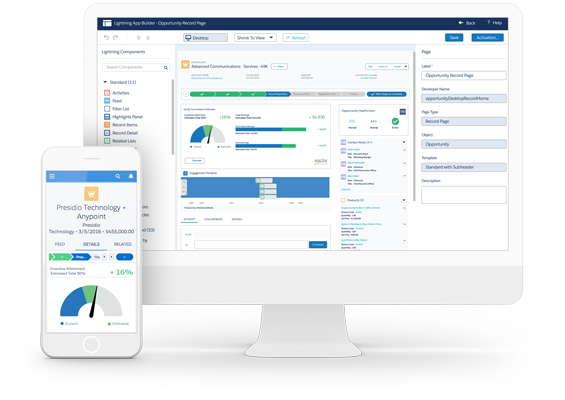To create an app successfully in this on-the-go age, where everyone is connected, there are a few things you need to know. Attention spans are shrinking and one-click engagement is the norm.
Start Creating Apps Today
With a few clicks, you can start creating custom cloud apps now.

Businesses can use apps to:
- Improve their processes
- Personalise content
- Highlight their branding
- Create seamless customer journeys
- Provide real-time updates and more
But how can companies that don’t have a robust IT department up their app game to better connect with their base? Is there a low-code app platform that non-experts can use to turn their bright ideas into paradigm-shifting products? There is now.
A step-by-step process for creating an app with no coding knowledge
If you’ve never built an app before, a low-code app platform like the one offered by Salesforce makes it easy. To create an app with zero experience, you can start by simply asking the right questions:
Who is going to use the app?
Knowing your user is one of the first places to start when creating an app, so put yourself in their place and ask what you would want from that app, and how you would want it delivered. How can that app provide an exceptional experience for your unique user?
It’s also important to know how digitally savvy your users are, and how user-friendly the app needs to be. Make sure that the app you want to create will enhance your user’s experience – not complicate it.
What is the problem you’re trying to solve?
Many apps start as solutions to problems, so it’s important to pinpoint exactly what pain points you want to address. Successful leaders and entrepreneurs find creative solutions to problems, so delivering an app that solves problems in a new way will get attention quickly, even if the solution is simple.
For instance, Salesforce developed an app that enabled all of its employees to use a single sign-on to access hundreds of apps. This streamlining measure saved each employee an average of 15 minutes a day and saved the company over a million dollars.
What are the required functionalities of the app?
Be as detailed as possible when mapping out the functionalities of your app. Walk through the process of using the app, listing all the steps you envision along the way. Once you have a list of your core functionalities, you can see if there are any other features you want to add, and then turn your focus towards design.
When is the app needed?
Since the Salesforce Platform makes it easy to create an app with zero experience, perhaps the primary factor in deciding whether to build or buy is time. If there’s no rush to create the application, then creating an app from the ground up is a great idea. However, if there’s someone in the next room screaming that they needed the app yesterday, you may want to consider buying a pre-built app and then customising it.
Why do you need to create an app?
There’s no doubt that enterprise mobility is a hot topic, and businesses that aren’t offering apps to increase their mobile presence are falling behind. The Google Play Store and the Apple App Store had a combined 33.6 billion app downloads in Q1 of 2020 alone, so the mobile imperative is definitely here.
Apps are great for building engagement and increasing profiles, but having an app that meets a specific, unaddressed need is even better. You can use analytical tools, such as Google Keyword Planner, to identify problems that people are searching for solutions to and see if your app might be able to address them. Learn more about creating mobile apps.
The build or buy dilemma
Use Salesforce Lightning to build applications with point-and-click tools that have been designed to be user-friendly, or just purchase pre-designed apps with core functionality built-in. No matter whether you choose to buy or build, creating an app will better connect your business with the world. So go ahead and build your mobile-ready masterpiece on the Salesforce Platform, your audience is waiting.

Even businesses with strong IT teams don’t always have the time to build something from scratch, so the Salesforce Platform makes it easy to get into the app game quickly.
What is the Salesforce Platform?
The Salesforce Platform is a low-code app platform that makes it easy to create an app with zero experience. If you can point, click and drop, you can create an app on the Salesforce Platform. And if you don’t have the time to build an application from scratch, the Salesforce Platform offers a range of innovative apps with core technologies already built-in: just customise them to fit your needs.
How do I create an app on Salesforce?
Creating an app on the Salesforce Platform is easier than you think; all you need to do is drag and drop components. If you can imagine, point and click, you can create apps on the Salesforce Platform. Best of all, Salesforce apps can go mobile right away. Meaning, they’re perfectly suited for today’s on-the-go mindset.

Speaking of mindsets, the Salesforce Platform’s ability to put anyone in the driver’s seat is sure to stoke the fires of imagination. In an age when innovation is a top priority – but organisations aren’t quite sure how to nurture it – empowering a workforce to easily build their own creative solutions could be a game-changer.
Here are some of the other benefits that businesses can discover if they decide to create apps on the Salesforce Platform.
Create apps, build the future: Advantages of the Salesforce Platform
It’s fast and flexible
Creating apps on the Salesforce Platform is quick and easy, enabling businesses to rapidly respond to new challenges and changing priorities. By creating and deploying apps on the Salesforce Platform, companies can deliver intelligent and engaging customer experiences that boost their business now, not months or years down the road.
It’s connected
The average organisation uses an astounding 900 apps. Navigating between all these digital tools is a time-killer, so connecting them quickly and efficiently is key. Unfortunately, according to the 2020 Connectivity Benchmark Report, only 28% of businesses have managed to connect or integrate their apps. So the vast majority of companies are lost in an endless digital labyrinth. The Salesforce Platform uses Mulesoft to unify data, build a single view of the customer, and create connected experiences — getting you out of the labyrinth and into the game.
It’s adaptable
Businesses can use the Apex programming in Lightning to create employee-facing apps with point-and-click tools. And IT departments can easily iterate and customise these.

They can also create external-facing apps using a number of different programming languages in Heroku. Heroku’s apps can link to social media accounts, enabling users to engage straight from the app.
You’ve got company
If you don’t want to create apps on the Salesforce Platform from scratch, Salesforce offers a range of innovative pre-made applications. Simply pick the applications that have suitable core functionalities, and then tailor them to match your needs.
How Salesforce uses Salesforce
Salesforce loves using apps created on the Salesforce Platform. In fact, our Volunteerforce app has transformed the lives of employees by connecting them with meaningful opportunities. And our single sign-on has enabled our employees to access apps from any device with just one sign-on, saving the organisation over a million dollars. And to think, both these apps started with just a simple idea and the ability to point and click. What will the Salesforce Platform do for you?
Start Creating Apps Today
With a few clicks, you can start creating custom cloud apps now.









